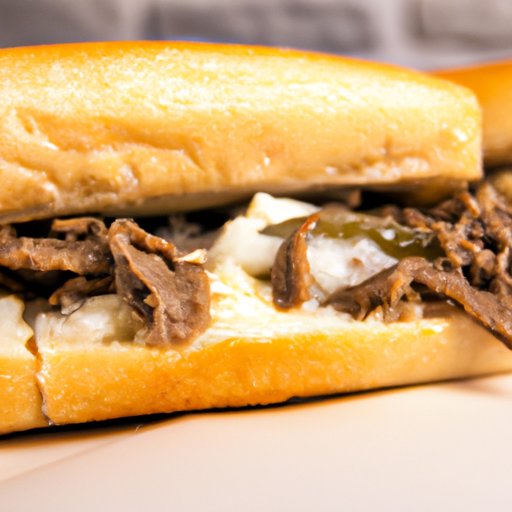Introduction
A Philly cheese steak is a type of sandwich that originated in Philadelphia, Pennsylvania. It consists of thinly sliced beef, melted cheese, and onions or peppers, all piled onto a long roll. While the exact origin of the sandwich is unknown, it has become a popular dish throughout the United States and beyond. But is it actually healthy? In this article, we’ll explore the pros and cons of eating a Philly cheese steak, as well as ways to make it a healthier option.

Examining the Health Risks Associated with Eating a Philly Cheese Steak
When it comes to the nutritional value of a Philly cheese steak, there are both benefits and risks associated with eating it. Let’s take a closer look at some of the potential health concerns.
High Fat Content
The main component of a Philly cheese steak is the beef, which is usually high in fat. Depending on the cut of meat used, it can contain anywhere from 12-25 grams of fat per serving. This can add up quickly if you’re eating multiple servings in one sitting.
Sodium Content
In addition to being high in fat, a Philly cheese steak also tends to be high in sodium. The average sandwich contains around 800-1000 milligrams of sodium, which is about 40-50% of the recommended daily intake. Eating too much sodium can increase your risk for high blood pressure and other health issues.
Potential Allergen Concerns
Finally, those with food allergies should be aware of the potential allergens in a Philly cheese steak. Cheese, beef, and wheat are all common ingredients, so anyone with an allergy to any of these should avoid eating a Philly cheese steak.
Exploring the Pros and Cons of Eating a Philly Cheese Steak
Now that we’ve examined some of the potential health risks associated with eating a Philly cheese steak, let’s take a look at the benefits and drawbacks of including it in your diet.
Pros
Despite the health risks associated with eating a Philly cheese steak, there are still some benefits to be had. Here are a few of them:
Source of Protein
One of the main benefits of eating a Philly cheese steak is the protein content. A single sandwich can contain up to 25 grams of protein, which is a great way to get your daily requirement. Protein is essential for muscle growth and repair, so it’s important to include it in your diet.
Contains Vitamins and Minerals
In addition to protein, a Philly cheese steak also contains a variety of vitamins and minerals, such as calcium, iron, and vitamin B12. These are all essential for maintaining good health, so eating a Philly cheese steak can help you meet your daily needs.
Can Be Low in Calories
If you opt for a leaner cut of beef and use low-fat cheese, you can make a Philly cheese steak that’s relatively low in calories. This makes it a great option for those looking to maintain or lose weight.
Cons
Of course, there are still some drawbacks to eating a Philly cheese steak. Here are a few of them:
High in Fat
As mentioned above, a Philly cheese steak is usually high in fat. While some of this fat is healthy (such as monounsaturated and polyunsaturated fats), too much of it can lead to weight gain and other health problems.
High in Sodium
Another downside of eating a Philly cheese steak is the high sodium content. Eating too much sodium can increase your risk for high blood pressure and other health issues, so it’s important to limit your intake.
Risk of Allergens
Finally, those with food allergies should be aware of the potential allergens in a Philly cheese steak. Cheese, beef, and wheat are all common ingredients, so anyone with an allergy to any of these should avoid eating a Philly cheese steak.

Comparing the Nutritional Value of a Philly Cheese Steak to Other Fast Food Options
When it comes to fast food, a Philly cheese steak isn’t necessarily the worst choice. To put it into perspective, let’s compare it to some of the other popular fast food options.
Fast Food Burgers
When compared to a fast food burger, a Philly cheese steak may actually be the healthier option. While burgers tend to be higher in calories and fat than a Philly cheese steak, they typically contain fewer carbs and sodium.
Fried Chicken
When compared to fried chicken, a Philly cheese steak is usually the better choice. Fried chicken is usually very high in fat and calories, while a Philly cheese steak can be lower in both when prepared properly.
Pizza
When compared to pizza, a Philly cheese steak is usually the healthier option. Pizza is usually very high in calories, fat, and sodium, while a Philly cheese steak can be lower in all three when made with leaner meats and low-fat cheese.

Creating a Healthier Alternative to the Traditional Philly Cheese Steak
If you still want to enjoy the taste of a Philly cheese steak without the added health risks, there are some easy ways to make it a healthier option. Here are a few tips:
Substituting Leaner Meats
Opt for leaner cuts of beef, such as top sirloin or flank steak. These cuts are lower in fat, which can help reduce the overall calorie and fat content of the sandwich.
Choosing Lower-Fat Cheese
Instead of using full-fat cheese, opt for a lower-fat variety. This will help keep the fat and calorie content of the sandwich down.
Avoiding Extra Toppings
Extra toppings, such as mayonnaise and ketchup, can add unnecessary calories and fat to the sandwich. Try to limit the amount of extra toppings you use, or skip them altogether.
Opting for Whole Wheat Bread
Finally, opt for whole wheat bread instead of white. Whole wheat bread is higher in fiber and other nutrients, making it a healthier choice.
Conclusion
At the end of the day, a Philly cheese steak can be a healthy option if prepared properly. By opting for leaner cuts of meat, choosing lower-fat cheese, avoiding extra toppings, and opting for whole wheat bread, you can make a Philly cheese steak that won’t derail your health goals. Of course, it’s still important to keep an eye on portion sizes and limit your intake.
Summary of Key Points
In summary, a Philly cheese steak can be a healthy option if prepared properly. It contains protein, vitamins, and minerals, but it can also be high in fat, sodium, and potential allergens. When compared to other fast food options, a Philly cheese steak can be the healthier choice. To make it even healthier, opt for leaner cuts of meat, choose lower-fat cheese, avoid extra toppings, and opt for whole wheat bread.
Final Thoughts
For those looking to enjoy the taste of a Philly cheese steak without sacrificing their health goals, there are some simple steps you can take to make it a healthier option. With the right preparation, you can enjoy the deliciousness of a Philly cheese steak without worrying about the health risks.
(Note: Is this article not meeting your expectations? Do you have knowledge or insights to share? Unlock new opportunities and expand your reach by joining our authors team. Click Registration to join us and share your expertise with our readers.)
